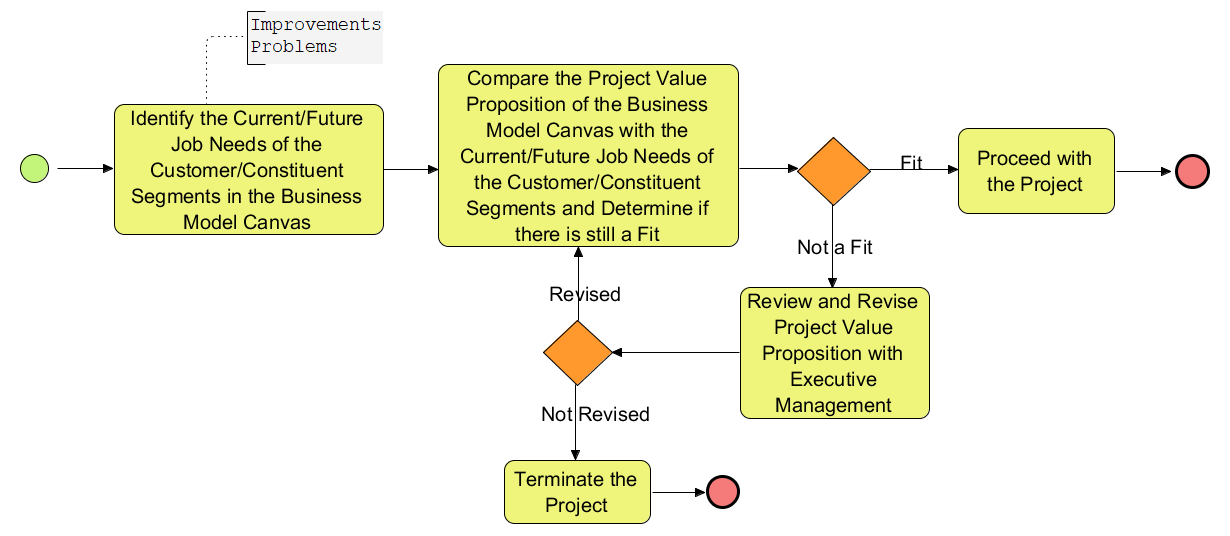Knowing the voice of the customer, the senior business analysts model1 the current business entity along with multiple possible visions. The analysts test the various visions and choose a single vision to pursue. The analysts then conduct a gap analysis on what changes are needed to the current model’s Value Proposition2. The Value Proposition is that component of the vision that shows how the business entity attracts customers through its product and services (i.e., matching-up with customer needs).
How are these Value Proposition changes implemented into the business entity? Unfortunately, changing a business entity is like making an elephant dance; it takes more than talk and talk is cheap (i.e., you can’t just say “make it so” like Captain Jean-Luc Picard in “Star Trek: The Next Generation”). In reality, it takes an initiative promoting the changes in-line with the strategic direction of the business entity along with a Value Proposition that matches up with the customer needs. The analysts present the initiative to an Executive Board. Upon the approval of the Executive Board, the Board transforms the initiative into an approved project. Over time, a Portfolio Manager funds the project and assigns project leadership.
Businesses Evolve to Survive
However, customer needs are constantly moving. If business entities wish to continue to be in business, they need to continue to attract their customers. Note the phrase,
over time, used above can mean days, weeks, even months; gosh, dare I say years. Business entities and customers are pushed by internal reorganizations and external market forces (e.g., laws, competition, etc.). For example, a new CEO may change the direction of the company, similarly an election could induct new public officials who have made different promises to constituents. As a result, the project is now misaligned with the new strategic direction and/or the Value Proposition is now mismatched with the customer needs.
Prior to proceeding with the project, the project leadership needs to validate the business alignment and the fit with the customer needs as when it was an initiative. If there is a match, the project leadership pursues the project. Otherwise, the project leadership needs to review the project with the executive board. The executive board either revises the project for business alignment and customer fit or terminates the project.
Ventures and New Products/Services
What if we are starting a new business (i.e., no current Value Proposition)? So far we have talked about capturing customer needs and matching them with a proposed Value Proposition. But if we are a venture or introducing a new product/service, the process flow is in the opposite direction. That is, we start with an entrepreneur designed Value Proposition with the hope of selling it to a customer. Regardless of the flow direction, project leadership still needs to validate the business alignment and the Value Proposition fit prior to the project kickoff.
Conclusion
Starting a new project is an exciting time, but before proceeding with the project, project leadership needs to pause the train at the station and ensure:
- the project still aligns with the strategic direction of the business entity and
- the proposed Value Proposition is still a match with the customer needs
Actually, the project leadership needs to periodically check the project alignment and its Value Proposition during project execution. If project leadership decides to skip this validation, worse case, management may strip them of their project charter and slowly parade them around a maze of cubicles followed by a hooded SME whispering “shame” while playing an annoying ring tone.
P.S. on Templates
Are there models that can help business analysts with this validation? Yep, see the references
Business Model Canvas1 and
Value Proposition Design2.

See below my process diagram on validating the project Value Proposition; note you should also ensure the project aligns with the business entity strategic direction.


|
Author: Mr. Monteleone holds a B.S. in physics and an M.S. in computing science from Texas A&M University. He is certified as a Project Management Professional (PMP®) by the Project Management Institute (PMI®), a Certified Business Analysis Professional (CBAP®) by the International Institute of Business Analysis (IIBA®), a Certified ScrumMaster (CSM) and Certified Scrum Product Owner (CSPO) by the Scrum Alliance. He holds an Advanced Master’s Certificate in Project Management (GWCPM®) and a Business Analyst Certification (GWCBA®) from George Washington University School of Business. Mark is also a member of the Association for the Advancement of Cost Engineering (AACE) International and the International Association of Facilitators (IAF).
Mark is the President of Monteleone Consulting, LLC and author of the book, The 20 Minute Business Analyst: a collection of short articles, humorous stories, and quick reference cards for the busy analyst. He can be contacted via – www.baquickref.com.
|
References
- “Business Model Generation: A Handbook for Visionaries, Game Changers, and Challengers”, July 13, 2010 by Alexander Osterwalder (Author), Yves Pigneur (Author)
- “Value Proposition Design: How to Create Products and Services Customers Want”, October 20, 2014 by Alexander Osterwalder (Author), Yves Pigneur (Author), Gregory Bernarda (Author), Alan Smith (Author), Trish Papadakos (Designer)